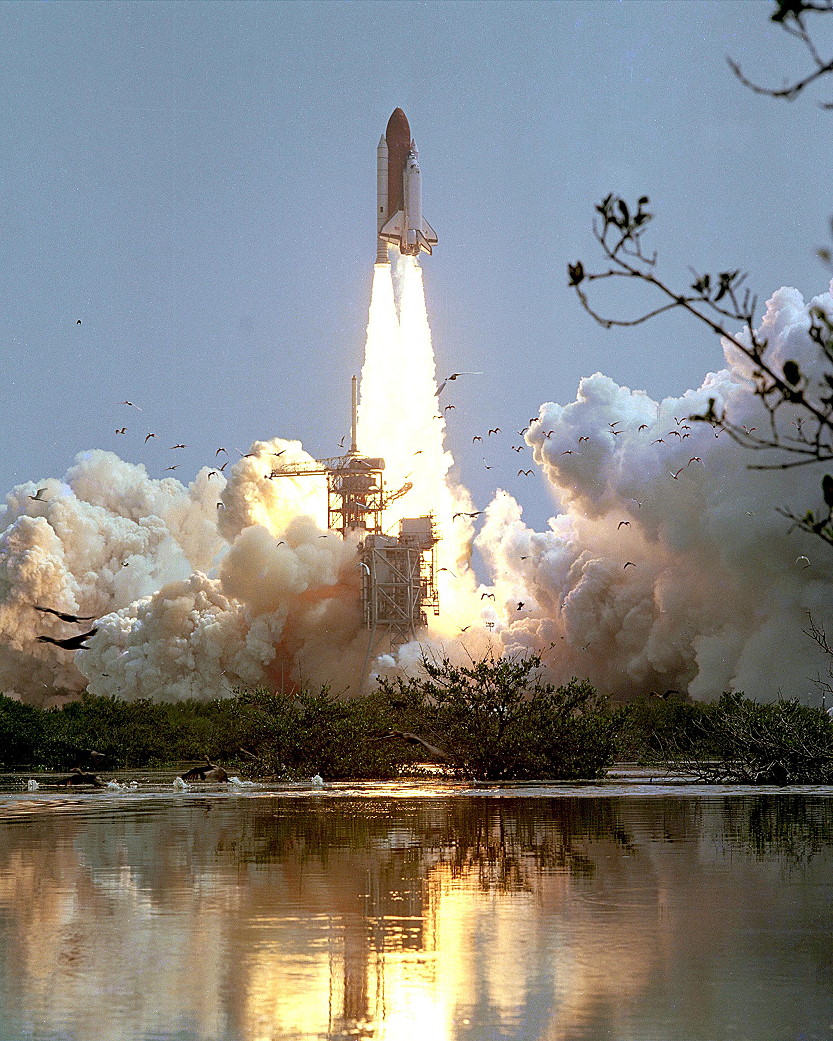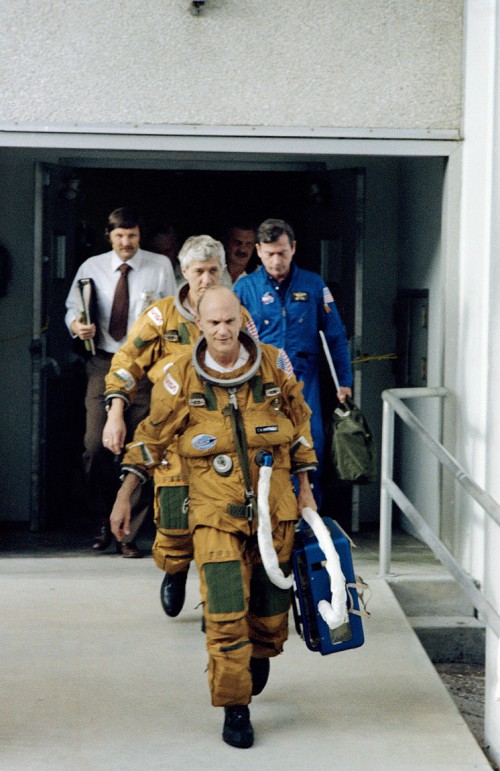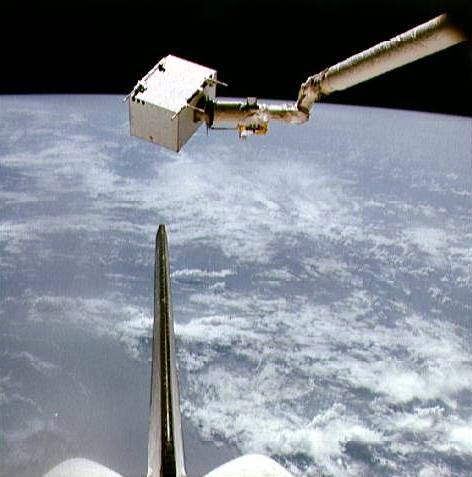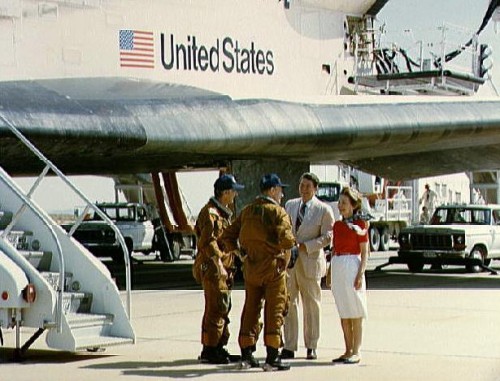
More than three decades ago, on Independence Day (4 July) in 1982, Columbia triumphantly touched down at Edwards Air Force Base, Calif., concluding the fourth shuttle mission. Aboard the reusable spacecraft were Commander Ken Mattingly and Pilot Hank Hartsfield. Theirs was the final Orbital Test Flight (OFT), after which the shuttle was supposedly to be declared fully “operational” and ready to conduct commercial missions for national and international customers, military missions for the Department of Defense, and scientific research missions with the European-built Spacelab. It was expected that by the end of the 1980s, the four members of the shuttle fleet—Columbia, Challenger, Discovery, and Atlantis—would be launching every two weeks, flying more than 20 times each year. However, as described in yesterday’s AmericaSpace history article, many within NASA doubted that such a feat was ever possible.
On the eve of the launch of STS-4, concerns were raised about Mattingly and Hartsfield’s chances of launching safely, because on the night of 26 June a severe hailstorm damaged several of Columbia’s thermal tiles and deposited water behind the covers of two Reaction Control System (RCS) thrusters. Despite the possibility that this water might freeze during ascent, it was eventually concluded that it would not pose a serious problem. Columbia lifted off precisely on time at 11:00 a.m. EDT, right at the opening of a four-and-a-half-hour window for that day, and quickly arced her way into the clear Florida sky for a planned seven-day mission.
For Mattingly, who had previously endured a bone-shaking Saturn V ascent, the shuttle offered the smoothest ride in the world. “It just goes!” he said later. Ascent, overall, was nominal, but a number of hydraulic sensors registered dramatic temperature drops in the nose landing gear wheel well, which required several hours to return to normal. Nothing like it had been seen in Columbia’s three previous launches, and it was attributed to rainwater penetration. More worryingly, other sensors recorded moisture behind a number of TPS tiles. This reinforced a decision by NASA managers, before launch, to fly the shuttle in a belly-to-Sun attitude to evaporate the water. This attitude was maintained for 12 hours, after which the crew began preparing for the “normal” attitudes planned for their mission. With the belly facing the Sun and the payload bay and overhead windows facing Earth, this offered them the opportunity for some magnificent views of orbital flight. “All of a sudden,” Mattingly noted, “it was like you pulled the shades back on a bay window … and the Earth appeared!”

The ascent, however, had gone somewhat awry for the twin Solid Rocket Boosters (SRBs), both of whose parachutes failed during their descent. They sank after splashdown in the Atlantic Ocean, and, although an underwater remote camera did succeed in photographing the wreckage, it was considered too expensive to recover them. The cause of the failure was subsequently traced to a new feature intended to separate the parachutes from the SRBs at the instant of splashdown to prevent them from being dragged through the water by their deflated canopies. This system had been “active” on the first three shuttle missions, but was partially disabled on STS-4 and frangible nuts holding one of two risers for each parachute were replaced by solid nuts which would not separate the riser. Preparations for STS-5 would see the replacement of all frangible nuts with solid ones. As a result, when Columbia next lifted off in November 1982, both risers on both parachutes remained attached to the boosters until they could be removed by recovery forces. The fix was successful.
Meanwhile, despite the half-day “soak” of Columbia in orbit, data indicated that water still lingered in several nooks and crannies. It was feared that, during “cold” periods, this might freeze and potentially crack the more sensitive tiles on areas which endured maximum atmospheric heating during re-entry. As a consequence, another “solar inertial” run, this time lasting for 23 hours, was added to the astronauts’ timeline for 29 June. It resolved the problem. In fact, maneuvering the shuttle into various attitudes to better understand its thermal behavior had long been a key objective for STS-4. “We had been assigned to do a bunch of thermal tests,” explained Mattingly, “where you put the orbiter in an attitude and get one side hot, and then one side cold, and then spin it around. They were collecting the data [because], after this flight, we wouldn’t have the [Development Flight Instrumentation] to do that. It was something that had to be done, but was really not a glamorous kind of test that you can run.”
Sitting in Mission Control throughout these exercises was Capcom Mike Coats. He described the thermal behavior of the shuttle as “the banana effect,” for during orbital flight its skin flexed, as one side “expanded” and the other “contracted.” During a practice opening and closure of Columbia’s payload bay doors under extremely cold conditions, problems arose after one period in the belly-to-Sun attitude. A “closed” indicator on one of the doors was not achieved, prompting Coats to advise Mattingly and Hartsfield to reverse their attitude and warm up the orbiter’s topside. This procedure, as well as 10 hours of so-called “barbecue roll” and another two hours in a tail-to-Sun orientation, thankfully resolved the issue and the door opening and closure was satisfactorily demonstrated several times. A thorough understanding of the factors impacting the satisfactory closure of the payload bay doors was critical before the shuttle could be declared fully operational; for if a crew was unable to close them properly, a safe return to Earth would be impossible. For the remainder of her mission, Columbia spent 67 hours in a tail-to-Sun attitude and on 3 July underwent a 10-hour barbecue roll to thermally stabilize herself for re-entry.
In effect, Mattingly and Hartsfield could insert the shuttle into the required attitude, then leave her alone until it became necessary for another orientation change. In the meantime, they had a multitude of other tasks to undertake. Of pivotal importance among these were the final series of tests of the Remote Manipulator System (RMS) mechanical arm. Mattingly and Hartsfield’s primary work with the RMS was the deployment and maneuvering of the Induced Environmental Contamination Monitor (IECM), which had been forestalled on STS-3, due to a failure of the arm’s wrist camera. In total, the astronauts completed two successful deployment and berthing exercises with the device, lasting around nine hours in total, and commented positively on the arm’s “crisp and precise” handling characteristics.

They also evaluated a new berthing device in the payload bay—a “Retention Engagement Mechanism” (REM) —and acquired good images of the IECM on their monitors in Columbia’s aft flight deck. Images of the bay itself, though, were restricted, to keep the Department of Defense’s 82-1 payload carefully under wraps. It seems that, in addition to the CIRRIS sensor, there were six other instruments, all of them affixed to a cross-bay “bridge,” known as an Experiment Support Structure (ESS). These all bore their own elaborate titles and hinted at a range of atmospheric, navigational, plasma physics, and attitude investigations: the Horizon Ultraviolet Program (HUP), the Autonomous Navigation and Attitude Reference Systems (ANARS), the Shuttle Effects on Plasma in Space (SEPS), the Sheath and Wake Charging (SWC), a set of passive cosmic-ray collectors, and a pallet alignment model.
Each apparently functioned without incident … except, ironically, for CIRRIS itself, which was foiled by the failure of its lens cap to open. Mission controllers in Houston discussed the possibility of either knocking it free with the RMS or sending Mattingly outside on a spacewalk to manually open it, but it was eventually decided not to complicate what was, after all, an experimental mission. “Payloads” on the OFT missions were a bonus and CIRRIS, despite the impatience of its sponsor, would have to await another chance to demonstrate its flair in space. Not surprisingly, Ken Mattingly was keen to do an EVA. The new space suit for the shuttle was still untested and the procedures for donning and doffing it in microgravity had to be fine-tuned. That honor fell to Mattingly, and on STS-4 he did get the opportunity to suit himself up for a spacewalk. The only problem, he said later, was that “I didn’t get to open the door!”
The military experiments had already drawn sufficient criticism to delete a planned reconnaissance camera from STS-4, and the dismal failure of CIRRIS only magnified the Air Force’s embarrassment. In fact, the overly secretive nature of the mission turned into something of a joke, especially for the crew. “A funny thing happened on that flight,” recalled Hank Hartsfield. “On one experiment, they had a classified checklist [and] because we didn’t have a secure comm link, we had the checklist divided up in sections that just had letter-names, like Bravo Charlie, Tab Charlie, Tab Bravo, that they could call out.” Whenever the crew talked to Air Force controllers at the Satellite Control Facility in Sunnyvale, Calif., they would be told, for example, to “Do Tab Charlie.” “We had a locker that we kept all the classified material,” continued Hartsfield, “and it was padlocked, so once we got on orbit, we unlocked it and did what we had to do.” As the end of the mission neared, Hartsfield packed away the remainder of the classified materials and secured the locker.
He told Mattingly. “I got all the classified stuff put away. It’s all locked up.”
“Great!” replied Mattingly.

Half an hour later, Mission Control in Houston called and told them that the military staff at Sunnyvale, Calif., wanted to talk to them. The Air Force controller asked them, cryptically, to “do Tab November.” The two astronauts looked at each other, bewildered. What the hell was Tab November? Neither of them could remember. The secret nature of the military instruction and the lack of a secure communications link also meant they could not ask over the radio. The only option was to reopen the classified locker, dig through all the materials, and find the checklist. Eventually, after much searching, Hartsfield finally found the glossary entry for Tab November.
It read: Put everything away and secure it!
Columbia’s return home on Independence Day, 4 July 1982, was watched closely by President Ronald Reagan, and Mattingly and Hartsfield had already been briefed by NASA Administrator Jim Beggs and asked to think of some memorable words to mark the occasion. “We knew they had hyped-up the STS-4 mission, so that they wanted to make sure that we landed on the Fourth of July,” Mattingly continued. “It was in no uncertain terms that we were going to land on the Fourth of July, no matter what day we took off. Even if it was Fifth, we were going to land on the Fourth! That meant, if you didn’t do any of your test mission, that’s okay, as long as you land on the Fourth … because the President is going to be there! We thought that was kinda interesting.”
Fortunately, Columbia’s landing—the first on Edwards’ concrete Runway 22—came precisely on time on Independence Day afternoon, completing a textbook flight. Unlike the experience of Jack Lousma and Gordon Fullerton on STS-3, the landing gear was deployed at an altitude of around 390 feet (120 meters), a full 20 seconds before touchdown, allowing all six wheels to be firmly locked into position with plenty of time to spare. The vehicle landed just past the runway threshold, and Mattingly applied the brakes for 20 seconds to bring Columbia to a smooth halt. Now came his biggest challenge: How to welcome Reagan inside the shuttle? He and Hartsfield had considered putting up a big notice, worded to the effect of: Welcome to Columbia: Thirty minutes ago, this was in space. As circumstances transpired, Mattingly actually welcomed his commander in chief with a rather painful forehead. …
Immediately after wheelstop, he turned to Hartsfield and spoke. “I am not going to have somebody come up here and pull me outta this chair! I’m going to give every ounce of strength I’ve got and get up on my own!” Previous crews had come back to Earth, some feeling fine, others feeling nauseous, and still others requiring a gurney to carry them off for medical attention. That would not happen with the President Reagan in attendance. Mentally and physically set up to meet the chief, Mattingly pushed himself upward out of his seat … and smashed his head sharply on the overhead instrument panel!
“Oh, did I have a headache,” he recalled later.
Nevertheless, the two returning space heroes composed themselves, Mattingly wiped away the few spots of blood, descended the steps, and smartly saluted Reagan. The test flights were over and the shuttle’s operational history had begun.
This is part of a series of history articles, which will appear each weekend, barring any major news stories. Next week’s article will focus on the 45th anniversary of Apollo 11, which completed humanity’s first piloted landing on another world in July 1969.
Want to keep up-to-date with all things space? Be sure to “Like” AmericaSpace on Facebook and follow us on Twitter: @AmericaSpace



